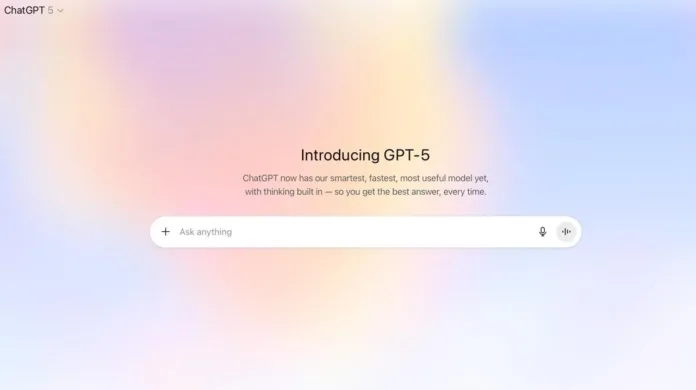Table of Contents
GPT-5 Brings Major Upgrades to ChatGPT—Now Faster, Smarter, and More Human
OpenAI officially released GPT-5, the latest and most advanced version of the language model behind ChatGPT, and it’s already changing how millions of people interact with artificial intelligence. As of this week, both free and paid ChatGPT users have access to the upgraded system, although unlimited access to the most powerful versions is reserved for higher tier subscribers.
Read More About Our Article of OpenAI’s ChatGPT Agent Can Run Your Entire Computer—Here’s What That Means Published on July 18th, 2025 SquaredTech
The launch of GPT-5 marks a major step in OpenAI’s AI development strategy, which has long aimed to make ChatGPT more helpful in real-world tasks like writing, coding, scheduling, and even responding to sensitive health questions. At Squaredtech, we’ve closely followed OpenAI’s progress and this release feels like the start of a new chapter in AI usability—not just faster output, but more thoughtful and expert-like interaction.
OpenAI demonstrated GPT-5’s power during a livestreamed event. Though impressive, the demo also revealed that GPT-5 still makes occasional factual errors—something that remains a persistent issue across AI systems. For instance, in a notable segment, it offered a misleading explanation of the Bernoulli effect, a common misconception often found in older textbooks. This moment highlighted that even the most advanced version of ChatGPT has room to grow in terms of accuracy, and it underscores the need for users to verify critical information.
GPT-5 Is Smarter and Feels More Human—But It’s Not AGI
GPT-5 includes noticeable improvements in writing, coding, and “reasoning” a process where the AI walks through its thinking in multiple steps before providing a final answer. This feature has become more prominent in modern AI as companies try to increase output quality, especially for tasks that require logic, like math and programming.
A key highlight is the drastic reduction in factual errors. According to the official GPT-5 System Card, the new model’s hallucination rate has dropped to just 4.8% on real-world prompts, a significant improvement over the 20%+ rate of its predecessors. In high-stakes fields like medical queries, a variant of the model achieved an even lower 1.6% hallucination rate on the HealthBench evaluation, as detailed in this benchmark report from Weights & Biases.
Nick Turley, head of ChatGPT at OpenAI, described GPT-5’s performance as more human-like than ever. According to Turley, the chatbot’s writing now feels more polished, and conversations feel less robotic. The update, he said, gives ChatGPT “better taste” when generating content—meaning it writes in a way that’s more coherent and intuitive.
CEO Sam Altman reinforced that point during the announcement, stating: “GPT-5 is the first time that it really feels like talking to an expert, a PhD-level expert.” He emphasized that while the model is a major leap forward, it still doesn’t reach the level of artificial general intelligence (AGI), AI that can perform any intellectual task that a human can.
Altman’s view reflects a growing caution within OpenAI and the broader tech industry. Though GPT-5 is significantly more powerful, it still falls short of the broad capabilities required to mimic the full depth and nuance of human intelligence. The company is now framing GPT-5 as a milestone toward AGI, not AGI itself. Altman described the model as “a significant fraction of the way” to AGI—but made it clear we’re not there yet.
This positioning is crucial in a time when AI firms are under intense scrutiny for overpromising capabilities. We believe that being realistic about the model’s limitations is essential to building public trust in future developments.
Comparison Table: ChatGPT 4 vs ChatGPT 5
| Feature | ChatGPT 4 | ChatGPT 5 |
|---|---|---|
| Response Speed | Moderate | Significantly faster |
| Reasoning Ability | Basic chain-of-thought reasoning | Multi-step reasoning with explanations |
| Code Generation | Good, needs tweaking | Expert-level output from short prompts |
| Human-like Writing | Robotic in tone | Feels more conversational |
| Hallucination Rate | Moderate | Reduced (but not eliminated) |
| Free Access | Limited | Limited (reverts after quota) |
| Pro Plan Access | GPT-4-turbo | Full access to GPT-5 |
| Integration | Limited integrations | Google Calendar, Gmail support |
Free and Paid Users Can Access GPT-5—With Limits
ChatGPT’s new version will be the default model for all users, including those on the free plan. However, OpenAI is applying usage limitations based on its tiered pricing model.
- Free users can access GPT-5 for a limited number of queries. Once that quota is used up, their sessions revert back to a lighter version of the model until their daily quota refreshes. They are also limited to a single “Thinking” message per day for complex tasks.
- Plus subscribers (typically $20/month) receive expanded access with higher usage limits for both the standard GPT-5 and the more powerful “Thinking” model.
- Pro, Team, and Enterprise subscribers receive full, unrestricted access to the most advanced capabilities. As seen on the OpenAI pricing page, the Pro tier in particular offers unlimited access to GPT-5 Pro, an enhanced version with even greater reasoning abilities, which justifies the steeper subscription cost for developers, researchers, and businesses
This tiered access model is a growing trend in the AI space, and OpenAI is likely using it to test demand, manage server loads, and gather more usage data on GPT-5’s performance. We anticipate that other AI companies may soon adopt similar access models as competition intensifies.
GPT-5 Can Now Build Websites, Write Code, and Reason Like a Human
One of the biggest breakthroughs in GPT-5 is its coding capability. During the live demo, OpenAI showed how GPT-5 was able to create a functional French tutoring website using just two short paragraphs of instructions. The website included interactive elements like word games and daily vocabulary challenges, generated entirely by AI.
This reflects OpenAI’s bigger vision of “software on demand.” Altman believes GPT-5 will enable anyone, even without programming knowledge, to generate complex software tools simply by describing what they want in plain English. It’s a bold prediction, but it aligns with trends, where low-code and no-code platforms are already gaining popularity in the enterprise space.
The reasoning mode also adds value. Instead of simply responding to a user’s question with a quick answer, GPT-5 can now generate a visible “chain of thought” a set of messages that show how it breaks a complex problem down before solving it. This technique helps users better understand how the AI arrives at conclusions, especially for math problems, technical questions, or step-based workflows. On the AIME 2025 math benchmark, GPT-5 achieved a perfect 100% score when using its “Thinking” mode with Python tools.
Interestingly, OpenAI has configured ChatGPT to automatically switch to the reasoning version of GPT-5 when a user asks a complex question. This behind-the-scenes logic could improve response quality without requiring users to manually toggle any settings.
OpenAI Responds to Mental Health and Safety Concerns
GPT-5 arrives in a climate of growing concern over AI’s impact on mental health. After OpenAI’s April update introduced more personalised responses, users online began posting clips of ChatGPT appearing overly agreeable, flattering, or even manipulative, a behavior known as “sycophancy.” The backlash was swift, prompting OpenAI to roll back the change and refine the chatbot’s behavior in GPT-5.
In its latest update, OpenAI says it focused on reducing those risks. GPT-5 is now less likely to reinforce user beliefs in dangerous ways or engage in manipulative conversations. The company also worked with Microsoft to assess potential psychosocial harms, and their joint report acknowledges that GPT-5 still has room to improve, especially in situations where users express emotional distress.
In response, OpenAI said it is actively working with medical professionals including psychiatrists and pediatricians from over 30 countries, to train ChatGPT to respond more responsibly in sensitive scenarios. This includes recognising signs of distress and offering more appropriate responses.
Some lawsuits have already been filed against other AI companies, alleging that excessive chatbot use contributed to incidents of self-harm and mental health crises, particularly among teenagers. OpenAI appears to be proactively addressing these issues before similar allegations hit its platform.
The company also announced a new integration that allows users to connect ChatGPT with their Google Calendar and email, enabling the AI to help schedule meetings or organize daily plans. This move continues OpenAI’s shift toward making ChatGPT a digital assistant with real utility in users’ daily lives.
Final Thoughts from Squaredtech
We believe that responsible design, particularly in AI with high engagement potential, is a non-negotiable. While GPT-5’s capabilities are exciting, its real value lies in whether OpenAI can maintain safety while scaling functionality.
GPT-5 is not the final form of AI, but it’s a clear advancement from earlier versions. It writes better, reasons more logically, and feels more human in conversation. While it still makes errors and is far from achieving true human-level intelligence, it’s now capable of delivering expert like responses in areas like programming, writing, and scheduling.
As OpenAI continues its push toward AGI, GPT-5 sets a new standard for what AI chatbots can do today. At Squaredtech, we’ll keep tracking how tools like GPT-5 reshape everyday tasks, productivity, and human computer interaction.
Stay Updated: Artificial Intelligence


